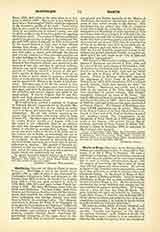

Martianus Capella, Roman writer of Africa who flourished in the fifth century. His work is entitled: “De nuptiis philologiae et Mercurii”. It was composed after the taking of Rome by Marie (410) and before the conquest of Africa by the Vandals (429). The author, a native of Madaura, Apuleius’s birthplace, had settled in Carthage where he earned a precarious living as a solicitor. He proposed to write an encyclopedia of the liberal culture of the time, dedicated to his son Martianus, and this work he planned like the ancient “Satyra”, that is a romance which was a medley of prose and verse. The original conception was both bizarre and entertaining. Mercury has grown weary of celibacy but has been refused by Wisdom, Divination and Soul. Apollo speaks favorably of a charming and wise young maiden, Philologia. The gods give their consent to this union provided that the betrothed be made divine. Philologia agrees. Her mother Reflection, the Muses, the Cardinal Virtues, the three Graces surround her and bedeck her. Philologia drinks the cup of ambrosia which makes her immortal and is introduced to the gods. The wedding gifts are examined. Phoebe offers, in her husband’s name, a number of young women who will be Philologia’s slaves. These women are the 7 liberal arts: Grammar, Dialectics, Rhetoric, Geometry, Arithmetic, Astronomy and Harmony. The first and second books of “De Nuptiis” contain this allegory. Of the remaining books each one treats of an art. Art herself gives an exposition of the principles of the science she governs. Finally night has come. Architecture and Medicine are indeed present, but as they care for nothing but earthly things, they are condemned to remain silent. Harmony escorts the bride to the bridal chamber while nuptial songs are sung. Allegory, as we see, predominates in this work. In it, Martianus Capella notably departs from his model Apuleius and comes nearer medieval times. While the Psyche of Apuleius is a living person and her story a charming one, the personages of Martianus Capella are cold abstractions. His style also suffers in the attempt to imitate Apueleius, for he exaggerates the defects, incongruities, and pedantry of the latter, and is wanting in his qualities of grace, clearness and brilliancy. His verse is better than his prose, as is generally the case among the decadent writers.
The subject treated belongs to a tradition which goes back to Varro’s “Disciplinae”. The allusion to architecture and medicine in Martianus Capella is an idea borrowed from Varro who mentioned these arts in his book in connection with the other seven. And before this, in a celebrated passage in “De Officiis” (I, § 161) Cicero opposes medicine and architecture to the precepts which lead to the making of an honest man, while placing them among the liberal arts. In Martianus Capella’s day architecture and medicine were no longer taught in the schools, the curriculum of which was reduced to rhetoric and its accompanying arts. St. Augustine, broader minded, mentions architecture and medicine but does not group them with the other arts. Moreover, even in Varro, philosophy is represented only by dialectics. There again, St. Augustine attempted, but vainly, to broaden the narrow school plan and to introduce philosophy. The encyclopedia of human knowledge remained in medieval days as it had been represented to be by the Madaura barrister. Each book is an extract from, or a compilation of, earlier authors: book V (rhetoric), from Aquila Romanus and Fortunatianus; book VI (geometry, including geography), from Solinus and, in an abridged form, from Pliny the Elder; and book X (music), from Aristide’s “Quintilian”. Varro must also have been largely drawn upon, and, possibly, through Varro, Nigidius Figulus, for data of a religious and astrological order. This encyclopedic work of Martianus Capella is one of the books which exercised a lasting influence. As early as the end of the fifth century, another African, Fulgentius, composed a work modeled on it. In the sixth century Gregory of Tours tells us that it became, in a way, a school manual (“Hist. Franc.”, X, 449, 14 Amdt). It was commented upon by Scotus Erigena, Hadoard, Alexander Neckam, Remy of Auxerre. Copies of “De Nuptiis” increased in number; as early as the middle of the sixth century Securus Memor Felix, a professor of rhetoric, received the text in Rome. The book, which is thoroughly pagan and in which one vainly seeks any allusion to Christianity, was the mentor of teachers and suggested the figures of the seven arts which adorn the facades of the cathedrals of the time. A critical edition was published at Leipzig in 1866.
PAUL LEJAY

